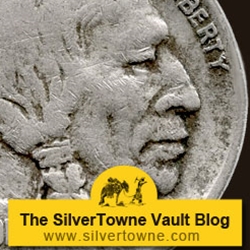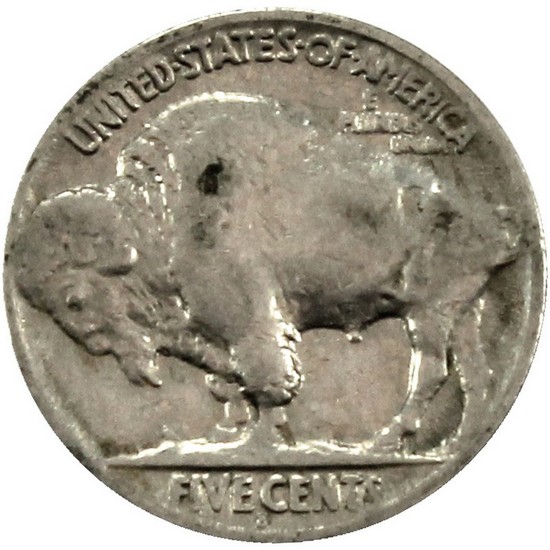
Buffalo Nickel
The Buffalo Nickel, also referred to as the Indian Head Nickel, is perhaps the most widely-collected circulating coin in American history, or at least the most well-known. This in no small part is due to the designs on the obverse and reverse of the coin – both of which have a very Americana, old-west feel to them. Also contributing to their popularity was the accessibility of the nickel to the general population (with more than 1.2 billion being struck across all variations between 1913 and 1938).
Having been first introduced into circulation in 1913, the Buffalo Nickel celebrated its 100th year anniversary in 2013. The coin was only produced for 25 years, from 1913-1938 (with no Buffalo nickels released in 1922, 1932 and 1933), but the design and history of the nickel have preserved its popularity with collectors to this day.
The concept for the Buffalo Nickel came about during a sort of renaissance for United States coinage. President Theodore Roosevelt had a desire to beautify the country’s coinage, therefore many U.S. coins were redesigned during this time period. This effort led to the Buffalo/Indian Head design for the nickel being introduced to replace the Liberty Head Nickel design.
The Buffalo Nickel was designed by James Earle Fraser, a one-time student and assistant of the legendary designer/sculptor Augustus Saint-Gaudens. Fraser stated in a radio interview that his goal for the new design was to come up with something uniquely American. "When I was asked to do the nickel, I felt I wanted to do something totally American - a coin that could not be mistaken for any other country's coin. It occurred to me that the buffalo, as part of the western background, was 100 percent American, and that our North American Indian fit into the picture perfectly."
The obverse (front of the coin) depicts a Native American believed to be based on three different American Indians. There was some controversy surrounding this topic, with several Native American Chiefs from various tribes claiming to have modeled for Fraser during the design process – but in the end the designer only named two Chiefs that he worked with prior to his death, while he was unable to recall the name of a third. The two individuals that Fraser named were Chief Two Moons of the Cheyenne people and Chief Iron Tail of the Lakota Sioux people.
 The animal featured on the reverse (back of the coin) is actually a bison, not a buffalo, but the American Bison is popularly called a buffalo due to the similarities between the two species. The design for the nickel is believed to have been based on a popular resident at the Central Park Zoo in New York in the early 1900s, an American Bison named Black Diamond. Similar to the obverse design, there is some controversy about the reverse also, with some people pointing out that the horns on Fraser’s depiction don’t match exactly those of Black Diamond’s.
The animal featured on the reverse (back of the coin) is actually a bison, not a buffalo, but the American Bison is popularly called a buffalo due to the similarities between the two species. The design for the nickel is believed to have been based on a popular resident at the Central Park Zoo in New York in the early 1900s, an American Bison named Black Diamond. Similar to the obverse design, there is some controversy about the reverse also, with some people pointing out that the horns on Fraser’s depiction don’t match exactly those of Black Diamond’s.
Another interesting historical aspect of Buffalo Nickels involves their use in the creation of Hobo Nickels. The practice of making these coins came about as a way to pass idle hours during the Great Depression. In the 1930s, men across the United States lived a nomadic lifestyle, traveling on railways looking for work – these men were commonly referred to as hobos. The unique artwork of these Hobo Nickels became a valuable token for these men to earn money, food or a place to sleep at night. The preferred coin for hobos to carve was the most common nickel in circulation at the time, the Buffalo Nickel. The large Indian head profile on the obverse of Buffalo Nickels offered a canvas-like carving surface for hobos to create their designs on. The Buffalo Nickel was also the hardest US coin in circulation, made of a copper-nickel alloy, making it ideal for carving.
The design of the Buffalo Nickels led to it being susceptible to wear, particularly on the date area of the coin. This led to slight modifications from the original design to address the issue, but eventually the Jefferson Nickel was created as a replacement for Buffalo Nickels in 1938. On today’s collector market you will find Buffalo Nickels described as "Full Date", which indicates little wear allowing for the date to be readable, "Partial Date" for coins where the date is partially readable and "No Date" for those coins on which the date has been completely worn off.
Those wishing to collect Buffalo Nickels can still find plenty to choose from in various conditions located in coin shops and auctions across the country and online. Start or build on your own Buffalo Nickel collection today!







